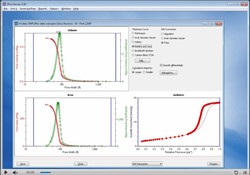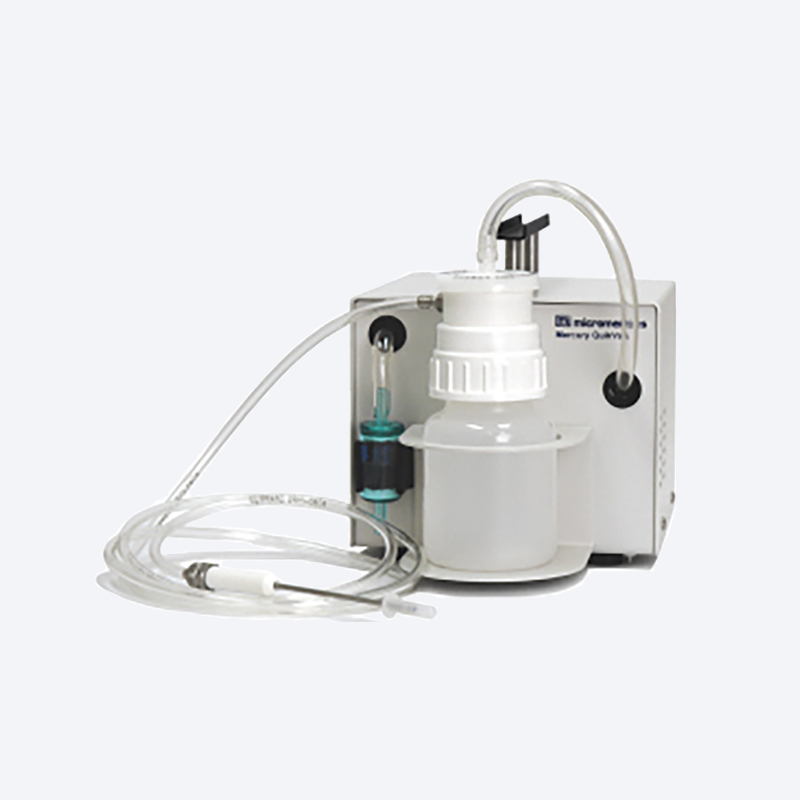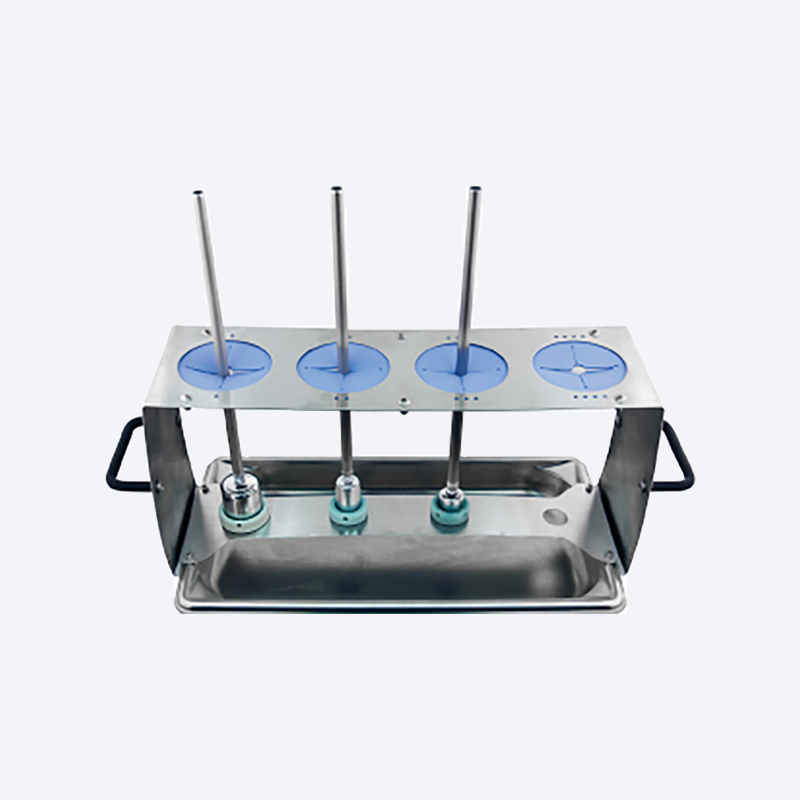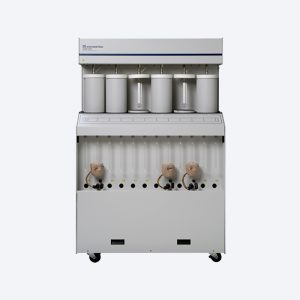Description
The AutoPore V Series Mercury Porosimeters can determine a broader pore size distribution more quickly and accurately than other methods. This instrument also features enhanced safety features and offers new data reduction and reporting choices that provide more information about pore geometry and the fluid transport characteristics of your material.
AutoPore V – Features
Optional Advantages:
- Ability to measure pore diameters from 0.003 to 1100 µm*
- Controlled pressure can increase in increments as fine as 0.05 psi from 0.2 to 50 psia. This allows detailed data to be collected in the macropore region
- High-resolution (sub-microliter) measurement of intrusion/extrusion volumes produces extraordinary precision allowing the Development of tighter sample specifications, improved production processes, and high-quality research data
- Operates in scanning and time- or rate-of-intrusion equilibrated modes
- Real-time diagnostics provide knowledge of an issue before it becomes critical or impairs your analytical results
- Collects extremely high-resolution data; better than 0.1 µL for mercury intrusion and extrusion volume
- Improved linear motion for high-pressure chamber closure
Design Advantages:
- Improved safety features reduce the risk of mercury spills and operator exposure
- Available with four low- and two high-pressure ports for increased sample throughput
- Available in 33,000 psia or 60,000 psia models
- Low-noise, high-pressure generating system
- A quick-scan mode allows a continuous pressure increase approximating equilibrium and providing faster screening
- A choice of correction routine for baseline (automatic, differential, or manual) produces greater accuracy by correcting for compressibility and thermal effects caused by high pressure
- Choice of pressure ramping methods lets you choose the scanning mode for high-speed or on-demand results, or equilibration mode for more accurate results with greater detail
- Mercury temperature sensor allows automatic calculation of mercury density used for penetrometer calibrations
- MicroActive software allows you to interactively manipulate data, define custom reports, and quickly achieve analytical results
- Compensation for material compression under high-pressure analysis
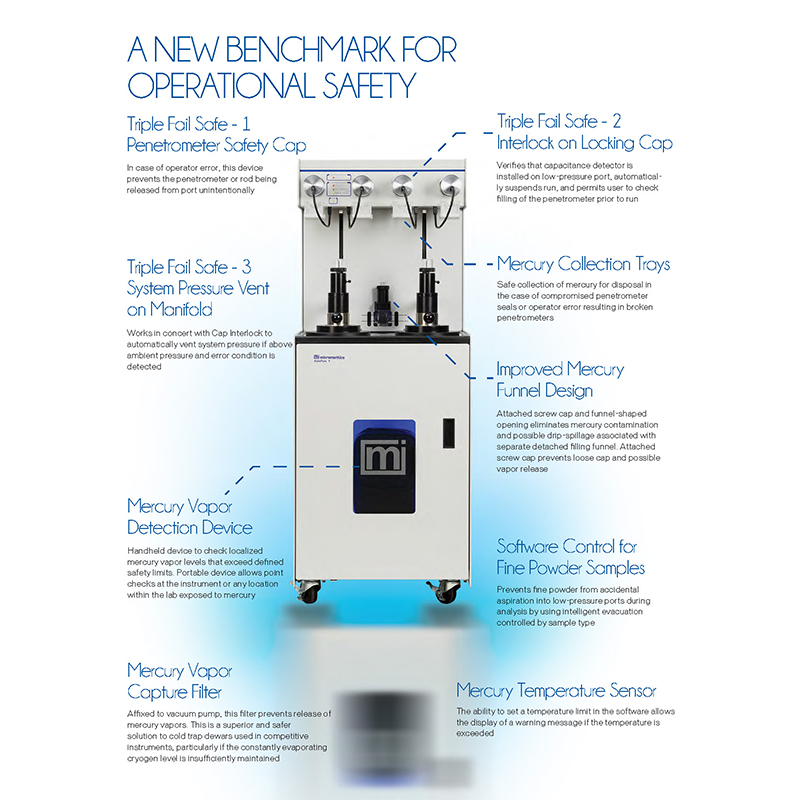
Autopore V – Models
Four Models Available:
The AutoPore V is available in four models to best match the needs of individual quality assurance and research labs.
| 9605 | 9620 | |
|---|---|---|
| Low Pressure | 4 Ports | 4 Ports |
| High Pressure | 2 Ports @ 33,000psia | 2 Ports @ 60,000psia |
AutoPore V – Accessories
Penetrometer Rack:
Safely store and transport penetrometers to prevent breakage and unnecessary replacement.

Mercury QuikVac:
Mercury QuikVac is an excellent low-cost method for quickly containing mercury spills. The device is designed to be specifically useful in collecting those elusive mercury droplets and small mercury-contaminated particulate matter.
Mercury is collected in a 250-mL recovery vessel and a replaceable 0.3 – 0.5 micron activated carbon filter assures that the device exhausts clean, safe air.
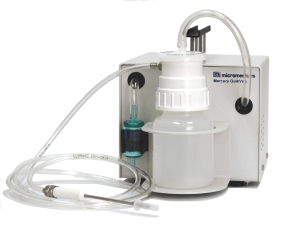
| Model # | Size | Stem Volume | Medium | Typical Use |
|---|---|---|---|---|
| 1 | 15cc | 0.392 | Solid | Refractories, low-porosity solid rocks/cores,low porosity solid polymers |
| 2 | 15cc | 0.392 | Powder | Low-porosity powders, gravel, irregular rock shapes |
| 3 | 15cc | 1.131 | Solid | Medium-porosity rocks/cores, solid materials |
| 4 | 15cc | 1.131 | Powder | Medium-porosity rocks, solid materials, fumed silica |
| 7 | 5cc | 0.392 | Solid | Paper, flexible polymer/membrane sheets, pharma tablets |
| 8 | 5cc | 0.392 | Powder | Silicates, catalysts, powders (general use), pharma powders |
| 9 | 5cc | 1.131 | Solid | Medium/high-porosity sheet-form materials (paper, polymer, etc.), pharma tablets |
| 10 | 5cc | 1.131 | Powder | Silica-alumina, silicates, zeolites, catalysts, powders (general use), pharma powders |
| 14 | 3cc | 0.412 | Powder | Powders (general use), materials with low quantity available |
| 24 | 15cc | 3.263 | Solid | High-porosity rock/cores, low-density/high-porosity foams |
| 25 | 15cc | 4.185 | Solid | High-porosity material with large volume |
Typical Applications
Pharmaceuticals:
Porosity and surface area play major roles in the purification, processing, blending, tableting, and packaging of pharmaceutical products as well as a drug’s useful shelf life, its dissolution rate, and bio-availability.
Ceramics:
Pore area and porosity affect the curing and bonding of greenware and influence strength, texture, appearance, and density of finished goods
Adsorbents:
Knowledge of pore area, total pore volume, and pore size distribution is important for quality control of industrial adsorbents and in the development of separation processes. Porosity and surface area characteristics determine the selectivity of an adsorbent
Catalyst:
The active surface area and pore structure of catalysts influence production rates. Limiting the pore size allows only molecules of desired sizes to enter and exit, creating a selective catalyst that will produce primarily the desired product.
Aerospace:
Surface area and porosity of heat shields and insulating materials affect weight and function
Fuel Cells:
Fuel cell electrodes require controlled porosity with high surface area to produce adequate power density
Geoscience:
Porosity is important in groundwater hydrology and petroleum exploration because it relates to the quantity of fluid that a structure can contain as well as how much effort will be required to extract it
Filtration:
Pore size, pore volume, pore shape, and pore tortuosity are of interest to filter manufacturers. Often, pore shape has a more direct effect upon filtration than pore size because it strongly correlates with filtration performance and fouling.
Construction Materials:
Diffusion, permeability, and capillary flow play important roles in the degradation processes in concrete, cement, and other construction materials.
Paper:
The porosity of print media coating is important in offset printing where it affects blistering, ink receptivity, and ink holdout
Medical Implants:
Surface area and porosity of heat shields and insulating materials affect weight and function
MicroActive Software for AutoPore V
Intelligent, Intuitive, Interactive:
MicroActive software greatly improves the functionality, convenience, diagnostics, and data interpretation that establish the new standard for high-performance results in mercury porosimetry.
Method Wizard:
Build a method through an interactive step-by-step script. Eases method creation and new user introduction to the operation of the AutoPore V.
Mercury Density Calculation:
Unlike competitive systems that use mercury density at ambient temperature only, the AutoPore V automatically measures the actual mercury temperature for accurate density calculations under operation conditions.
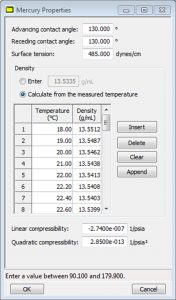
User-Defined Reports and Report Options:
You can quickly create custom advanced reports to meet your specific needs using Python scripting. New report options permit automatic report conversion to PDF or spreadsheet formats.
Post-Analysis Parameter Change:
Allows analysis parameters (stem volume, maximum head pressure, pen constant) to be changed or corrected post analysis, eliminating re-running samples due to error.
Enhanced Penetrometer Calibration:
Simplifies penetrometer calibration through automated calculations either volumetrically or gravimetrically.
Diagnostic Dashboard:
Real-time monitoring of critical system components for preventative maintenance and trouble shooting.
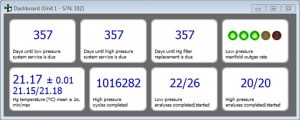
Overlay Multiple Runs and Gas Adsorption Data:
MicroActive for AutoPore V provides the ability to overlay up to 20 runs. Included is the option to import pore size distributions from gas adsorption isotherms to provide analysis data in the micro to macropore range in a single report.
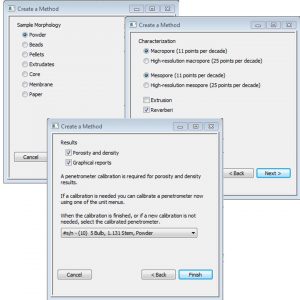
Intelligent Data Reporting:
Warnings are supplied automatically when suspect data are collected.
Variety of Available Plots:
Pore volume, pore area, and pore size plots are available as well as the ability to calculate total intrusion volume, total pore (surface) area, median pore diameters, average pore diameters, bulk or envelope density, and apparent (skeletal) density.
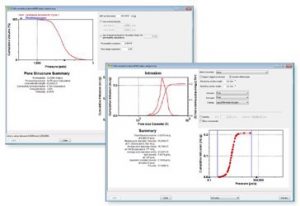
Reverberi Method Data Reduction:
Receive information on the distribution of pore shape. The method yields a three-dimensional array of cavity size and throat size vs. volume.
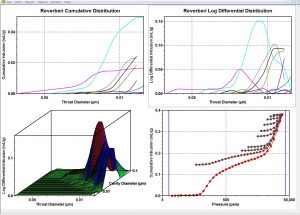
Available Information, Reports and Plots:
- Summary Report
- Cumulative Volume versus Pore size or Pressure
- Incremental Volume versus Pore size or Pressure
- Differential Volume versus Pore size
- Cumulative Area versus Pore size
- Log Differential Volume versus Pore size
- Differential Reference % Volume versus Pore sizeOut of Specification % Volume versus Pressure
- Difference from Reference % Volume
- Differential and Log Differential intrusion
- Material Compressibility
- Density versus Pressure
- Cavity to Throat Size Ratio
- Fractal Dimension
- Reverberi Method for Pore Throat and Pore Cavity
- Pore Network Tortuosity and Material Permeability
- Bulk, Envelope and Skeletal Density
- Mayer-Stowe Particle Size Distribution
